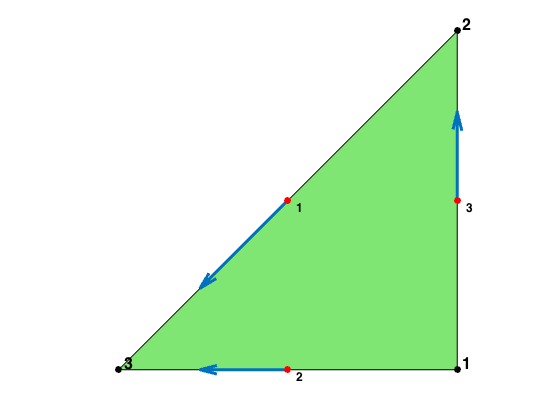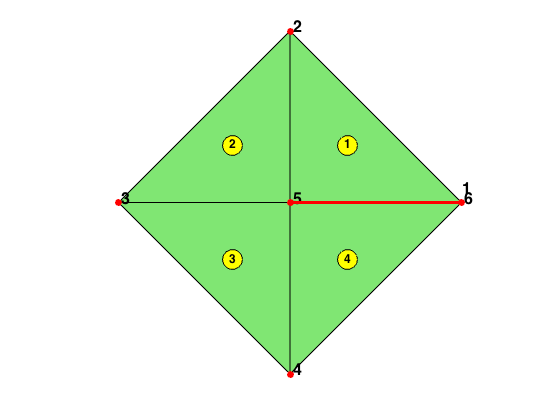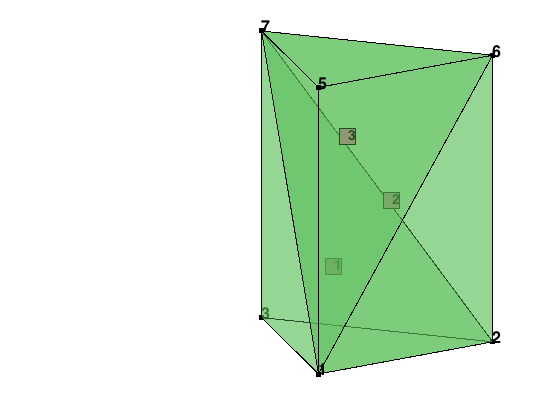Data Structure: Boundary Conditions
We use bdFlag(1:NT,1:3) to record the type of three edges of each triangle. Similarly in 3-D, we use bdFlag(1:NT,1:4) to record the type of four faces of each tetrahedron. The value is the type of boundary condition.
- 0: non-boundary, i.e., an interior edge or face.
- 1: first type, i.e., a Dirichlet boundary edge or face.
- 2: second type, i.e., a Neumann boundary edge or face.
- 3: third type, i.e., a Robin boundary edge or face.
Contents
Local labeling of edges and faces
We label three edges of a triangle such that bdFlag(t,i) is the edge opposite to the i-th vertex. Similarly bdFlag(t,i) is the face opposite to the i-th vertex.
node = [1,0; 1,1; 0,0]; elem = [1 2 3]; edge = [2 3; 1 3; 1 2]; showmesh(node,elem); findnode(node); findedge(node,edge,'all','vec');

Set up boundary conditions
The function setboundary is to set up the bdFlag matrix for a 2-D triangulation and setboundary3 for a 3-D triangulation.
help setboundary
SETBOUNDARY set type of boundary edges.
bdFlag = SETBOUNDARY(node,elem,'Dirichlet') set all boundary edges to
Dirichlet type.
bdFlag = SETBOUNDARY(node,elem,'Neumann') set all boundary edges to
Neumann type.
bdFlag = SETBOUNDARY(node,elem,'Robin') set all boundary edges to
Robin type.
bdFlag = SETBOUNDARY(node,elem,'Dirichlet','(x==1) | (x==-1)') set
Dirichlet boundary condition on x=1 and x=-1. Other edges are
homongenous Neumann boundary condition.
bdFlag = SETBOUNDARY(node,elem,'Dirichlet','(x==1) | ...
(x==-1)','Neumann','(y==1) | (y==-1)') set
Dirichlet boundary condition on x=1 or x=-1 and Neumann boundary
condition on y=1 or y=-1.
bdFlag = SETBOUNDARY(node,elem,'Dirichlet','(x==1) | ...
(x==-1)','Neumann','y==1', 'Robin',' y==-1') set
Dirichlet boundary condition on x=1 or x=-1 and Neumann boundary
condition on y=1, and Robin boundary condition on y=-1.
bdFlag = SETBOUNDARY(node,elem,'Dirichlet','all','Neumann','y==1') set
Neumann boundary condition on y=1 and others are Dirichlet boundary condition.
Example
node = [0,0; 1,0; 1,1; 0,1];
elem = [2,3,1; 4,1,3];
bdFlag = setboundary(node,elem,'Dirichlet','all','Neumann','y==1');
[node,elem,bdFlag] = uniformbisect(node,elem,bdFlag);
[node,elem,bdFlag] = uniformbisect(node,elem,bdFlag);
showmesh(node,elem);
allEdge = [elem(:,[2,3]); elem(:,[3,1]); elem(:,[1,2])];
Dirichlet = allEdge((bdFlag(:) == 1),:);
Neumann = allEdge((bdFlag(:) == 2) | (bdFlag(:) == 3),:);
findedge(node,Dirichlet,[],'noindex','LineWidth',4,'Color','r');
findedge(node,Neumann,[],'noindex','LineWidth',4,'Color','b');
See also setboundary3
Copyright (C) Long Chen. See COPYRIGHT.txt for details.
Note that if the i-th edge of t is on the boundary but bdFlag(t,i)=0, it is equivalent to use homogenous Neumann boundary condition (zero flux).
Example: Crack Domain
node = [1,0; 0,1; -1,0; 0,-1; 0,0; 1,0]; % nodes elem = [5,1,2; 5,2,3; 5,3,4; 5,4,6]; % elements elem = label(node,elem); % label the mesh figure; showmesh(node,elem); % plot mesh findelem(node,elem); % plot element indices findnode(node,2:6); % plot node indices text(node(6,1),node(6,2)+0.075,int2str(1),'FontSize',16,'FontWeight','bold'); hold on; plot([node(1,1),node(5,1)], [node(1,2),node(5,2)],'r-', 'LineWidth',3); bdFlag = setboundary(node,elem,'Dirichlet'); % Dirichlet boundary condition display(elem) display(bdFlag)
elem =
5 1 2
5 2 3
5 3 4
5 4 6
bdFlag =
1 0 1
1 0 0
1 0 0
1 1 0

node 1 and node 6 are the same point (1,0)
bdFlag = setboundary(node,elem,'Dirichlet','abs(x) + abs(y) == 1','Neumann','y==0'); display(bdFlag)
bdFlag =
1 0 2
1 0 0
1 0 0
1 2 0
Example: Prism Domain
node = [-1,-1,-1; 1,-1,-1; 1,1,-1; -1,1,-1; -1,-1,1; 1,-1,1; 1,1,1; -1,1,1]; elem = [1,2,3,7; 1,6,2,7; 1,5,6,7]; elem = label3(node,elem); figure; showmesh3(node,elem); view([-53,8]); findnode3(node,[1 2 3 5 6 7]); findelem3(node,elem); bdFlag = setboundary3(node,elem,'Dirichlet','(z==1) | (z==-1)'); display(elem) display(bdFlag)
elem =
1 7 2 3
1 7 6 2
1 7 5 6
bdFlag =
0 1 0 0
0 0 0 0
1 0 0 0

The top and bottom of the prism is set as Dirichlet boundary condition and other faces are zero flux boundary condition.
Remark
It would save storage if we record boundary edges or faces only. The current data structure is convenient for the local refinement and coarsening since the boundary can be easily update along with the change of elements. The matrix bdFlag is sparse but we use a dense matrix to store it. We do not save bdFlag as a sparse matrix since updating sparse matrix is time consuming. We set up the type of bdFlag or bdFlag to uint8 to minimize the waste of spaces.